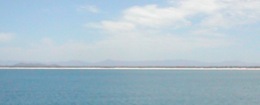Archaea are the third domain of life, as evolutionarily distinct from other microbes in the bacteria as they are from animals or plants. Two decades ago, surprising research found that archaea are present and extremely abundant within the ocean, but the role of these microbes in ocean chemistry and biology was not known. Recent evidence indicates that archaea carry out ammonia oxidation—the chemical oxidation of one form of nitrogen to another—in order to generate energy. This fits with other findings demonstrating that ammonia oxidation appears to be more important and prevalent in the sea than previously thought. This research project sought to merge these perspectives by examining archaeal ammonia oxidation in a critically important region of the ocean, the eastern tropical North Pacific (ETNP) and Gulf of California (GOC), and was funded by NSF from 2008-2012 (http://nsf.gov/awardsearch/showAward.do?AwardNumber=1034943).
Using leading-edge molecular and biogeochemical techniques, we quantified ammonia oxidation rates and the abundance of ammonia-oxidizing archaea (AOA) and bacteria (AOB) in tandem in the ETNP and GOC. Our findings indicate that AOA are the dominant ammonia-oxidizers in this region and that ammonia oxidation occurs rapidly (see Publications). We also measured rates of a coupled process, nitrite oxidation, about which much less is known. These rates were also high, and Nitrospina bacteria appeared to be quantitatively important. For both processes we observed substantial variation with depth and between sampling stations, and analyzed the environmental factors that may cause this variation.
Oxygen is a key factor in the GOC and ETNP because it reaches extremely low concentrations; this is driven by high rates of photosynthesis near the surface, as well as sluggish circulation at depth. Low oxygen waters such as these are expanding as a consequence of climate change, and this is likely to have profound implications for marine biogeochemistry and ecology. We found that both ammonia and nitrite oxidation persisted under low oxygen concentrations, but also examined the overall diversity and composition of bacterial communities found in these low oxygen waters using new DNA sequencing technologies. We found sharp changes in diversity and composition with depth, including significantly reduced diversity as oxygen concentrations decrease to low levels.
Altogether, the combination of approaches and data that we generated have contributed to our understanding of marine biogeochemistry and microbiology in multiple ways, including demonstration that archaea play an important role in ammonia oxidation; quantitative information on rates of ammonia and nitrite oxidation, and the distribution of different microbial groups; and recognition that ocean acidification and deoxygenation may alter microbial processes, such as ammonia oxidation, in the sea.
Photos:
Top left: Sonoran coast from the GOC; photo by Mike Beman
Lower left: bow-wake surfing porpoises; photo by Angel White
Right: Sunrise at Bahia del Tobari, Mexico; photo by Mike Beman
The views expressed on this page do not necessarily reflect those of the US National Science Foundation



